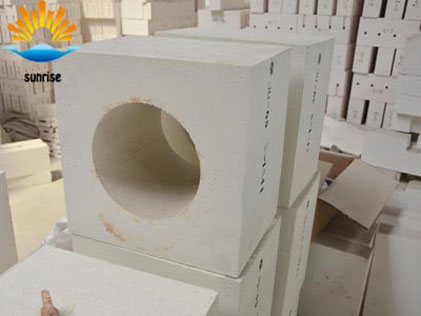Product
Fused Cast AZS Block
AZS Casting Type
AZS Ramming Materials
Fused Cast AZS TY-AZS41
Fused Cast AZS TY-AZS36
Fused Cast AZS TY-AZS33
Fused Cast Alumina Block
Fused cast Alumina Block TY-H
Fused cast Alumina Block TY-A
Fused cast Alumina Block TY-M
Fused Cast High Zirconia Block
Fused Cast Skid Rail Block
Silica brick
Magnesia Series Brick
Bonded Refractory Block
High alumina And Fire clay bricks
Insulation Series Brick
Ceramic Fiber Products
Contact Details
- 0086 371 63838939
- 0086 371 63835539
- sales@sunriserefr.com
- tkfanyi
- No.36 Fengchan Road, Zhengzhou City
Solutions
What Affects The Quality Of Mullite Bricks?
- More related products
- Fused Cast AZS Block
- Fused Cast Alumina Block
- Fused Cast High Zirconia Block
- Fused Cast Skid Rail Block
Mullite brick is a type of high alumina refractory with mullite as the main crystal phase. Generally, the content of alumina is 65%-75%. Besides mullite, mullite bricks with low alumina content also contain a small amount of glass phase and cristobalite; mullite bricks with high alumina content also contain a small amount of corundum.

Mullite bricks have high refractoriness(up to 1790℃), high refractoriness under load(1600-1700℃), cold crush strength(70-260MPa) and good thermal shock resistance. There are two types of mullite bricks: sintered mullite bricks and fused mullite bricks. Sintered mullite bricks are made of high alumina bauxite as the main raw material and clay or raw bauxite as the binder by molding and firing. Fused mullite bricks are made of high bauxite, industrial alumina and refractory clay as raw materials and fine charcoal or coke as a reducing agent by molding and fused reduction method.
From the above we can see factors affecting the quality and performance of mullite bricks include the following:
(1) The content of alumina and mullite
(2) Whether the physical and chemical properties can meet the production requirements of mullite bricks
(3) The refractoriness and refractoriness under load of mullite bricks
(4) Whether the fused cast and sintering method is in strict accordance with the requirements of the mullite brick production
(5) Whether the ratio of particles and fine powder as well as other raw materials is in accordance with requirements
(6) The kneading of mud, aging time and moisture
(7) The bulk density and fused casting and sintering of mullite bricks
Read more
Need more information? Drop us a line
For more information on any of our products please get in touch using the form below. One of our sales team will respond to your enquiry as soon as possible.
Copyright © 2014 Zhengzhou Sunrise Refractory Co., Ltd. Site Index Product IndexSitemap









